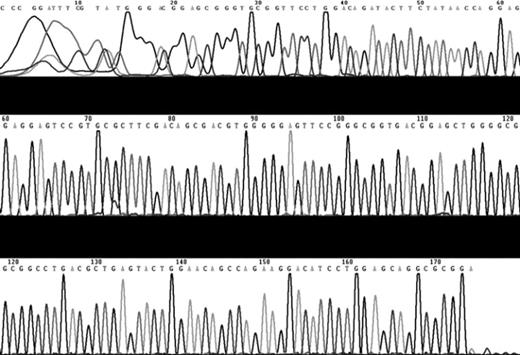Abstract
We investigate the frequency of the human leukocyte antigen DR15 (HLA-DR15) allele in patients with myelodysplastic syndromes (MDS). We used polymerase chain reaction-sequence-specific primers (PCR-SSP) to detect HLA-DR15 in the peripheral blood of patients with MDS(n = 76) and healthy controls (n = 227).
The frequency of HLA-DR15 in MDS patients (40.8%) was significantly higher than in controls (13.7%; P < 0.01).
The diagnoses of refractory anemia/refractory anemia with ring sideroblasts (RA/RARS) accounted for 77.4% (24/31) and 62.2% (28/45) of the DR15-positive and the DR15-negative patients, respectively (difference not statistically significant).
Although no statistically significant difference was observed, some trends were observed: IPSS low-risk MDS (IPSS score, ≤1) accounted for 80.6% of the DR15-positive patients compared to 64.4% among the DR15-negative patients. However, the difference between the numbers of DR15-positive and DR15-negative patients with chromosomal abnormalities was not statistically significant. Nevertheless, poor risk chromosome abnormalities (according to IPSS), were present in only 1 DR15-positive patient, while such abnormalities were present in 8 DR15-negative patients. In addition, the proportions of DR15-positive and DR15-negative patients with more than 5% blasts in marrow were 19.4% and 31.1%, respectively. Peripheral blood pancytopenia occurred in 51.6% of DR15-positive, and in 40.0% of DR15-negative patients.
Although the HLA-DR15 allele appeared to be present more frequently in patients less than 60 years of age, this association was not significant. The frequency of HLA-DR15 was significantly higher in patients with MDS than in healthy controls suggesting the possibility that HLA-DR15 is associated with an enhanced susceptibility to develop MDS. The fact that HLA-DR15 was predominantly noted in patients with RA/RARS and low IPSS scores, suggested that HLA-DR15 might be associated more with bone marrow failure and less with leukemic transformation.
clinical/experimental characteristics in HLA-DR15 positive or negative MDS patients
| Cohort . | HLA-DR15 positive(n=31) . | HLA-DR15 negative(n=45) . | P value . |
|---|---|---|---|
| RA/RARS(case/%) | 24/31(77.4) | 28/45(62.2) | 0.161 |
| Low risk (IPSS≤1) (case/%) | 25/31(80.6) | 29/45(64.4) | 0.126 |
| Karyotype abnormal(case/%) | 13/31(41.9) | 18/45(40.0) | 0.866 |
| Poor chromosome(case/%) | 1/31(3.2) | 8/45(17.8) | 0.117 |
| Blast>5%(case/%) | 6/31(19.4) | 14/45(31.1) | 0.253 |
| Pancytopenia(case/%) | 16/31(51.6) | 18/45(40.0) | 0.317 |
| Male patients(case/%) | 17/31(54.8) | 25/45(55.6) | 0.951 |
| age(<60 years) (case/%) | 20/31(64.5) | 20/45(44.4) | 0.085 |
| Cohort . | HLA-DR15 positive(n=31) . | HLA-DR15 negative(n=45) . | P value . |
|---|---|---|---|
| RA/RARS(case/%) | 24/31(77.4) | 28/45(62.2) | 0.161 |
| Low risk (IPSS≤1) (case/%) | 25/31(80.6) | 29/45(64.4) | 0.126 |
| Karyotype abnormal(case/%) | 13/31(41.9) | 18/45(40.0) | 0.866 |
| Poor chromosome(case/%) | 1/31(3.2) | 8/45(17.8) | 0.117 |
| Blast>5%(case/%) | 6/31(19.4) | 14/45(31.1) | 0.253 |
| Pancytopenia(case/%) | 16/31(51.6) | 18/45(40.0) | 0.317 |
| Male patients(case/%) | 17/31(54.8) | 25/45(55.6) | 0.951 |
| age(<60 years) (case/%) | 20/31(64.5) | 20/45(44.4) | 0.085 |
Author notes
Disclosure: No relevant conflicts of interest to declare.



This feature is available to Subscribers Only
Sign In or Create an Account Close Modal